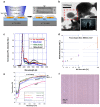Laser digital patterning of conductive electrodes using metal oxide nanomaterials
- PMID: 32632474
- PMCID: PMC7338299
- DOI: 10.1186/s40580-020-00232-9
Laser digital patterning of conductive electrodes using metal oxide nanomaterials
Abstract
As an alternative approach to the conventional deposition and photolithographic processes, the laser digital patterning (LDP) process, which is also known as the laser direct writing process, has attracted considerable attention because it is a non-photolithographic, non-vacuum, on-demand, and cost-effective electrode fabrication route that can be applied to various substrates, including heat-sensitive flexible substrates. The LDP process was initially developed using noble metal nanoparticles (NPs) such as Au and Ag because such materials are free from oxidation even in a nanosize configuration. Thus, the NPs must be fused together to form continuous conductive structures upon laser irradiation. However, common metals are easily oxidized at the nanoscale and exist in oxidized forms owing to the extremely large surface-to-volume ratio of NPs. Therefore, to fabricate conductive electrodes using common metal NPs via the LDP process, laser irradiation should be used to sinter the NPs and simultaneously induce additional photochemical reactions, such as reduction, and defect structure modification to increase the conductivity of the electrodes. This review summarizes recent studies on the LDP process in which metal oxide NPs, such as ITO, ZnO, CuO, and NiO, were exclusively utilized for fabricating conductive electrodes. The outlook of the LDP process for these materials is also discussed as a method that can be used together with or as a replacement for conventional ones to produce next-generation transparent conductors, sensors, and electronics.
Keywords: CuO; Digital patterning; ITO; Laser; NiO; Reductive sintering; ZnO.
Conflict of interest statement
The authors declare that they have no competing interests.
Figures








References
-
- Torii S, Yang W-J. J. Heat Mass Transf. 2005;48:537–544.
-
- Mustafeez W, Lee D, Grigoropoulos C, Salleo A. Opt. Express. 2011;19:15452–15458. - PubMed
-
- Yeo J, Hong S, Wanit M, Kang HW, Lee D, Grigoropoulos CP, Sung HJ, Ko SH. Adv. Funct. Mater. 2013;23:3316–3323.
-
- In JB, Lee D, Fornasiero F, Noy A, Grigoropoulos CP. ACS Nano. 2012;6:7858–7866. - PubMed
Publication types
Grants and funding
LinkOut - more resources
Full Text Sources
Research Materials
